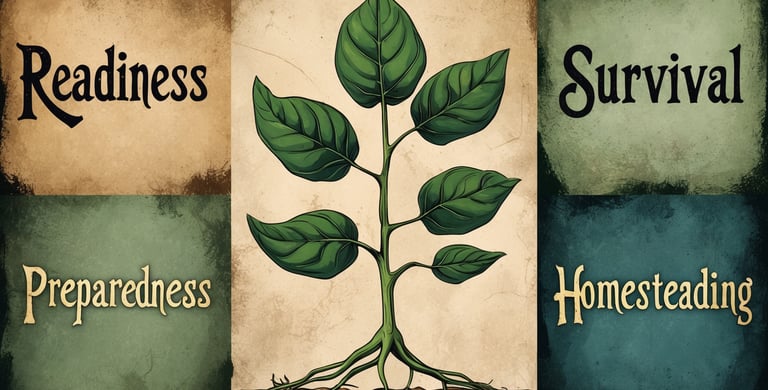Readiness: Leadership Readiness
Taking Initiative in Crisis, Calm in Chaos, and Moral Command
4FORTITUDER - READINESS, SURVIVAL, PREPAREDNESS, HOMESTEADING
Readiness: Leadership Readiness
Taking Initiative in Crisis, Calm in Chaos, and Moral Command
“A leader is best when people barely know he exists… but when his work is done, they will say: we did it ourselves.”
— Laozi
The Weight That Only the Prepared Can Carry
When the lights go out, someone must light the torch. When panic spreads, someone must speak calm. When no one moves, someone must take the first step. That someone—if you are truly ready—is you.
Leadership readiness is not about titles or tactics. It is the inner architecture of a man who takes responsibility not just for himself, but for others. He does not wait to be asked. He does not collapse into confusion. He steps forward with clarity, strength, and direction—even when no one follows yet.
As Marcus Aurelius wrote, “Waste no more time arguing what a good man should be. Be one.”
Core Knowledge Foundation: The Anatomy of Command
Leadership readiness means having the presence, wisdom, and process to guide others through uncertainty. It doesn’t require rank. It requires readiness of character.
Four Cornerstones:
Initiative – Move first when others freeze. Action before consensus.
Moral Authority – Lead with values, not manipulation. Courage + clarity = credibility.
Communication – Speak with precision, timing, and calm under pressure.
Decision-Making – Observe, orient, decide, act (OODA), then adjust. Keep momentum.
Misconception Warning: Leadership isn’t dominance. It’s service through strength. If your authority requires yelling, you haven’t earned it.
Advanced Insights: Chaos, Command Presence, and The Invisible Crown
True leaders radiate calm. They regulate the emotional atmosphere. In a crowd of panic, their tone anchors. In a room of doubt, their eyes focus. This is not charisma—it is discipline.
Historical Anchor: Lieutenant General Hal Moore (Battle of Ia Drang, 1965)
Surrounded, outnumbered, pinned under fire—Moore stayed mobile, encouraged his men, adjusted strategy mid-fight, and held the line. His presence under pressure was his greatest weapon. His men followed him not out of fear, but because they trusted his clarity.
Modern Leadership Readiness Includes:
Pre-Drilled Protocols – Have roles assigned before the event. Chaos is not the time for negotiation.
Contingency Scripts – Know what to say when power fails, shots are fired, or injury hits. Write it. Practice it.
Emotional Command – Practice crisis breathing, posture, and voice control. The room reacts to your presence before your words.
Tactical Drill:
Run a “24-hour leader scenario.” Act as if your area has lost power, communications, and order.
Rally your household or team.
Assign responsibilities.
Implement a calm, actionable plan.
Debrief their emotional reactions and your own.
Critical Perspectives: The Abdication of Male Leadership
Adversarial Viewpoint:
“Leadership should be shared. Taking charge in a crisis is patriarchal or authoritarian. Consensus matters more than command.”
Response:
In crisis, hesitation is death. Consensus requires stability. Leadership is not oppression—it is stewardship. In times of peace, guide. In times of war, lead. If you refuse to lead, someone else will—and you may not like where they take your people.
Wisdom and Warning Duality
When Followed: Your presence becomes a shield. Others calm around you. Plans form. Movement begins.
When Ignored: You become a spectator in chaos, watching others suffer, waiting for someone else to act.
Strategic Crossroad: Will you accept the burden of command—or abandon it when it’s needed most?
Final Charge & Implementation
Brother, leadership is not about being in charge. It is about being willing to carry the weight that others cannot. In every room, there is a silent question: “Who will take responsibility?” Let that answer be carved into your soul.
Start Now:
Draft Your Crisis Command Plan
“Leadership is clarity before crisis.” — 4FORTITUDE Leadership Doctrine
Assign roles for your family or team. Create a one-page action brief for: blackout, injury, home invasion, and evacuation. Practice once per month.Build Your Command Presence
“People trust the voice that doesn’t tremble.” — Tactical Influence Instructor
Practice 60-second crisis speeches. Say them to the mirror. Say them under breath. Say them under stress. Then speak them into real moments.
Strategic Reflection:
When others look to you in fear, what will your face, voice, and posture say about your readiness?
Existential Challenge:
If you don’t lead your people—who will? And can they be trusted with their souls, safety, or survival?
Lead because others won’t. Lead because you were called. Lead because you trained for this.
“A true leader doesn’t seek followers—he becomes the kind of man others follow when silence turns deadly.”


